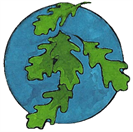

Coulter Pine, Pinus coulteri D. Don
Botanical
Also known as the California Coulter pine, Big-cone pine, Nut pine, and Pitch pine, is native to California. It is a slow growing species, reaching only 20 feet in 20 years. In optimal sites, it can grow as tall as 80 feet with a trunk diameter of 1-3 feet. Root depth is about 40 inches. The bark is grey on young trees, becoming dark purplish-brown or black with thick, scaly, broad ridges. Stiff, blue-green to grey-green needles are 3 bundled and about 10-12 inches long. The cones are the star of this tree. Weighing in at up to 5 pounds each, they are the heaviest pine cones in the world. Growing to 10 inches long, they have thick, woody, narrow and sharp scales that curve up like a claw. Coulter pine cones occur in whorls of 4 and persist (stay on tree) for 5-6 years.
Botanical
Also known as the California Coulter pine, Big-cone pine, Nut pine, and Pitch pine, is native to California. It is a slow growing species, reaching only 20 feet in 20 years. In optimal sites, it can grow as tall as 80 feet with a trunk diameter of 1-3 feet. Root depth is about 40 inches. The bark is grey on young trees, becoming dark purplish-brown or black with thick, scaly, broad ridges. Stiff, blue-green to grey-green needles are 3 bundled and about 10-12 inches long. The cones are the star of this tree. Weighing in at up to 5 pounds each, they are the heaviest pine cones in the world. Growing to 10 inches long, they have thick, woody, narrow and sharp scales that curve up like a claw. Coulter pine cones occur in whorls of 4 and persist (stay on tree) for 5-6 years.
Each contain many large, edible, brown seeds .8 inches in diameter. The crown varies in open and forested sites but typically is dense, broad and rounded. The life span of Coulter Pine is moderate and most reach at least 100 years of age.
Habitat
Most often found on steep south facing slopes between elevations of 500-7,000 feet, the Coulter pine prefers deep, well-drained, acidic soils. Moisture requirements vary between moist and dry for the soil but it does require 35-60 inches of rain annually and it has a low drought tolerance. Soils tend to be of medium texture, gravelly, or loamy. The minimum temperature for survival is 12°F and needs 220 frost free days. Large trees are resistant to low and moderately severe fires.
Habitat
Most often found on steep south facing slopes between elevations of 500-7,000 feet, the Coulter pine prefers deep, well-drained, acidic soils. Moisture requirements vary between moist and dry for the soil but it does require 35-60 inches of rain annually and it has a low drought tolerance. Soils tend to be of medium texture, gravelly, or loamy. The minimum temperature for survival is 12°F and needs 220 frost free days. Large trees are resistant to low and moderately severe fires.
Sources:
Trees of North America- A guide to field identification-a Golden Field Guide from St. Martin's Press © 2002 By C. Frank Brockman p.30
The Encyclopedia of North American Trees by Sam Benvie. Firefly Books Ltd., 2000 Buffalo, NY © 2000 Sam Benvie p.165
USDA, NRCS. 2011. The PLANTS Database (<http://plants.usda.gov/>, 22 August 2011). National Plant Data Team, Greensboro, NC 27401-4901 USA.
Cope, Amy B. 1993. Pinus coulteri. In: Fire Effects Information System, [Online]. U.S. Department of Agriculture, Forest Service, Rocky Mountain Research Station, Fire Sciences Laboratory (Producer). Available: http://www.fs.fed.us/database/feis/ [2011, August 22].
Trees of North America- A guide to field identification-a Golden Field Guide from St. Martin's Press © 2002 By C. Frank Brockman p.30
The Encyclopedia of North American Trees by Sam Benvie. Firefly Books Ltd., 2000 Buffalo, NY © 2000 Sam Benvie p.165
USDA, NRCS. 2011. The PLANTS Database (<http://plants.usda.gov/>, 22 August 2011). National Plant Data Team, Greensboro, NC 27401-4901 USA.
Cope, Amy B. 1993. Pinus coulteri. In: Fire Effects Information System, [Online]. U.S. Department of Agriculture, Forest Service, Rocky Mountain Research Station, Fire Sciences Laboratory (Producer). Available: http://www.fs.fed.us/database/feis/ [2011, August 22].
Photo citation: © 1995 Saint Mary's College of California
State List: CA
Visit the Image Gallery for more pictures
View all North American native pine tree species
Visit the Image Gallery for more pictures
View all North American native pine tree species

Want to add your tree to our picture gallery? Click here for details!
-Color denotes a tree that is rare or endangered

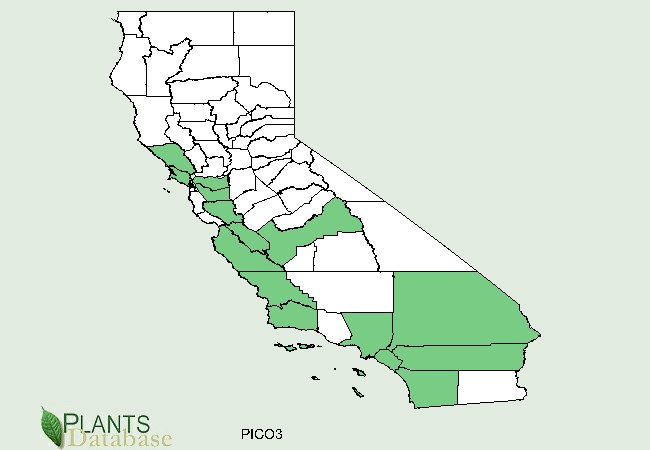
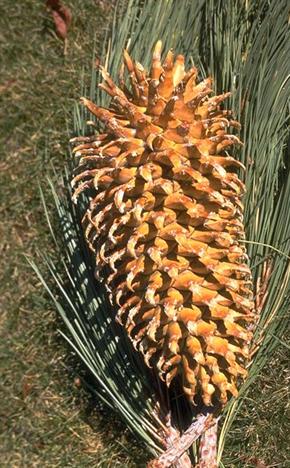
Map courtesty USDA NRCS PLANTS Database
Coulter pines have the heaviest pine cones in the world! Each one can weigh as much as 5 pounds!





- Trees
- A-Z scientific
- A-Z by Common Name
- Families
- Aceraceae Maple Family
- Anacardiaceae Sumac Family
- Annonaceae Custard Apple Family
- Aquifoliaceae Holly Family
- Arecaceae, Palm Family
- Betulaceae Birch family
- Bignoniaceae Trumpet Creeper Family
- Burseraceae Frankincense Family
- Caprifoliaceae Honeysuckle Family
- Chrysobalanaceae Coco-plum Family
- Cornaceae Dogwood Family
- Cupressaceae Cypress Family
- Cyrillaceae Cyrilla Family
- Ebenaceae Ebony Family
- Ericaceae Heath Family
- Fabaceae Pea Family
- Fagaceae Beech Family
- Hamamelidaceae Witch Hazel Ffamily
- Hippocastanaceae Horse Chestnut Family
- Juglandaceae Walnut Family
- Lauraceae Laurel Family
- Leitneriaceae Corkwood Family
- Magnoliaceae Magnolia Family
- Meliaceae Mahogany Family
- Moraceae Mulberry Family
- Myricaceae Bayberry Family
- Myrsinaceae Myrsine Family
- Myrtaceae Myrtle Family
- Nyctaginaceae Four Oclock Family
- Olacaceae Olax Family
- Oleaceae Olive Family
- Pinaceae Pine Family
- Platanaceae Plane Tree Family
- Polygonaceae Buckwheat Family
- Rhamnaceae Buckthorn Family
- Rosaceae Rose Family
- Rubiaceae Madder Family
- Rutaceae Rue Family
- Salicaceae Willow Family
- Sapindaceae Soapberry Family
- Sapotaceae Sapodilla Family
- Simaroubaceae Quassia Family
- Styracaceae Storax Family
- Symplocaceae Sweetleaf Family
- Theaceae Tea Family
- Tiliaceae Lindon Family
- Ulmaceae Elm Family
- Taxaceae Yew Family
- Yucca Family
- Browse by State
- Rare or Endangered Species
- Trees_with_Special_Uses
- Tallest and Biggest
- Noxious Weeds
- Causes
- About Us
- Our Stores
™

Custom Search
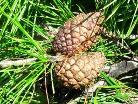
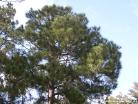
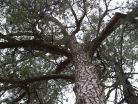
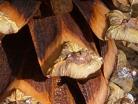
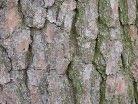
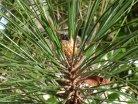
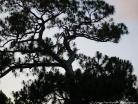
Tree lists:
•A-Z by scientific
name
•A-Z by common
name
•By Family
For state A-Z list click state name below.
•A-Z by scientific
name
•A-Z by common
name
•By Family
For state A-Z list click state name below.

Uses
Uses include lumber, nursery products, pulpwood and veneer. Coulter pine also makes an excellent landscape tree through all stages of its life but should be given ample space to grow. It is better suited for recreational areas like parks rather than typical residential settings.
Uses include lumber, nursery products, pulpwood and veneer. Coulter pine also makes an excellent landscape tree through all stages of its life but should be given ample space to grow. It is better suited for recreational areas like parks rather than typical residential settings.
Wildlife
Wild life note- the females of a southern race of Whiteheaded Woodpeckers feed almost exclusively on insects found on the lower trunks and the males eat seeds from the cones.
Wild life note- the females of a southern race of Whiteheaded Woodpeckers feed almost exclusively on insects found on the lower trunks and the males eat seeds from the cones.


